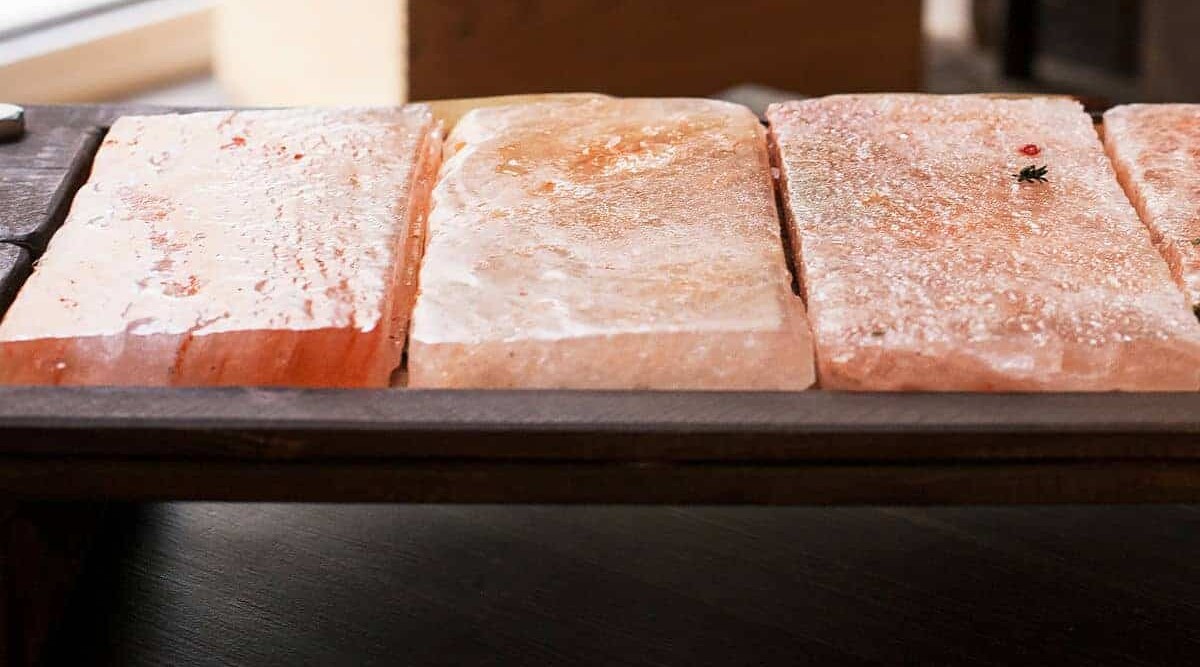
We all know to use the freshest ingredients when cooking. But how about cooking with something that’s 600-million years old? Now that’s table talk!
Serve up a steak on a rock that’s older than the land we’re standing on, and it’s certain to fire up some great conversation at your next gathering.
Yes, in this article we’re talking Himalayan salt block grilling.
But what exactly is Himalayan pink salt? The latest foodie fad? Or an essential addition to every serious griller’s arsenal?
Here, we’ll talk a little about the origins and composition of this fascinating natural wonder of the Earth. And we’ll talk a lot about why — in a world of Teflon, silicone, and fluoropolymers — this cooktop from Nature is hands-down the best, most flavorful and (surprise!) most sanitary surface to grill on.
Simple, beautiful and inexpensive, this one is indeed a no-brainer. If you don’t already have one, get ready to click on Amazon right after you finish reading!
Jump to:
- 1 What is Himalayan Salt, and Where Does It Come From?
- 2 7 Reasons to try Himalayan Salt Block Grilling
- 3 What Size and Shape of Himalayan Salt Block is Best?
- 4 What Can You Cook on a Salt Block?
- 5 How Does Salt Block Grilling Flavor Food?
- 6 Are Salt Blocks Hygienic?
- 7 Salt Block Stardom: How to Impress the Guests!
- 8 Salt Blocks Chill Too!
- 9 How Do You Clean and Store Salt Blocks?
- 10 How Long Do Salt Blocks Last?
- 11 Is Grilling with Salt Blocks Healthy?
- 12 How to Prepare a Salt Block for Grilling
- 13 Will the Salt Block Change when Heated?
- 14 How to Grill Using a Salt Block
- 15 How Can You Tell if the Salt Block is Hot Enough?
- 16 Top Tips for Successful Salt Block Grilling
- 17 Salt Block Grilling: When the Old Ancient Thing is the New Best Thing!
What is Himalayan Salt, and Where Does It Come From?
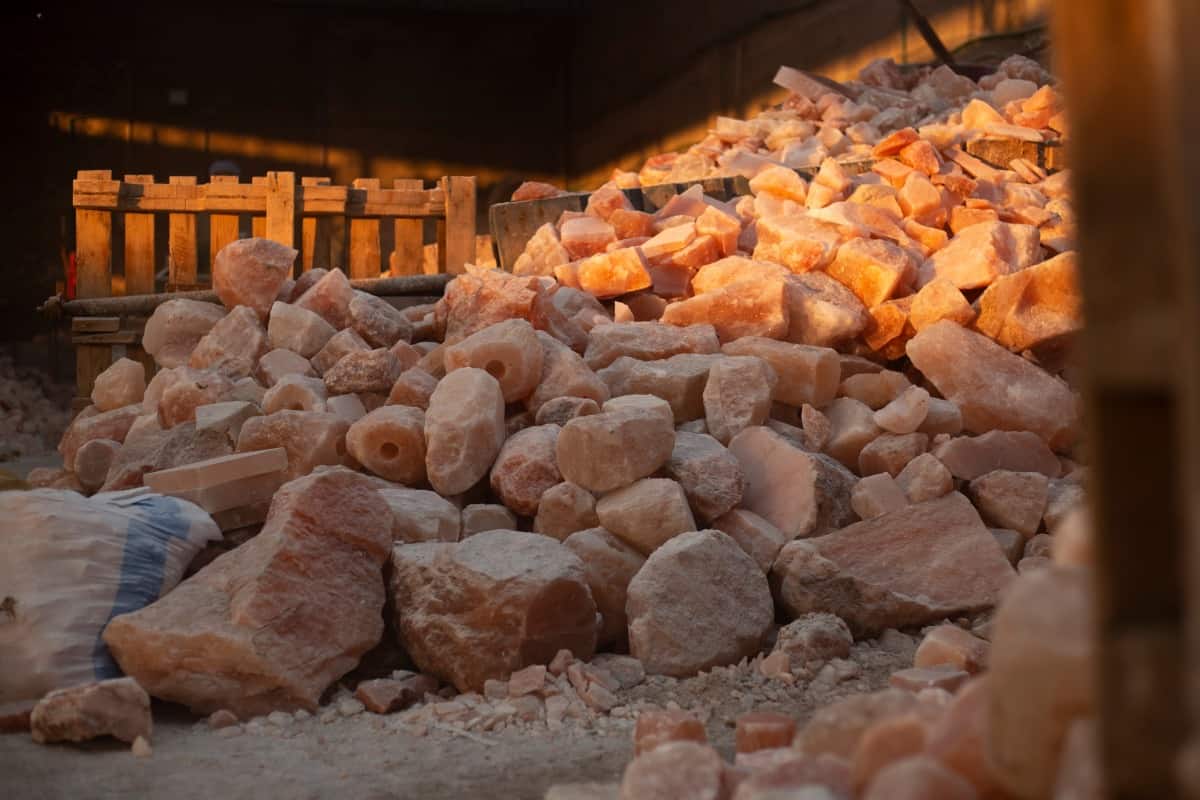
Well, for starters, it’s not Himalayan. I don’t know where this ancient story took a wrong turn, but in fact, this blush-pink beauty comes from the northern mountains of Pakistan, the result of a prehistoric land-locked sea that had evaporated and turned to salt.
Over a few hundred million years or so, movement of the continental plates caused these salt deposits to get pushed up into the mountains where today they are mined by local stonemasons. Fascinating!
And before we get on to the deliciousness, I have one more fun fact for you. History tells us that around 326 BC, Alexander the Great’s soldiers “discovered” this intensely flavored salt when they noticed their horses licking it off the rocks, and it’s likely been mined ever since. Great story! True? Who knows…
Like the majority of the different types of salt, 100% natural from Mother Earth herself, Himalayan salt is in large part the same as table salt, chemically speaking. But unrefined, and with the unique addition of multiple minerals and trace elements which will give complexity and subtlety of flavor to food cooked on it.
The presence of magnesium, calcium, potassium, and iron would suggest that Himalayan salt has health benefits, although since these make up just 2% of the total weight, the effects are likely minimal.
7 Reasons to try Himalayan Salt Block Grilling
- The natural non-stick surface is perfect for searing meat.
- The crystalline content ensures perfect heat distribution throughout the entire cooking surface
- The seasoning is built-in! Enhanced complexity and subtle salting of food is all done automatically by the block itself.
- Chills brilliantly too. Serving sushi on a hot day? Serve it on a chilled salt block and your guests won’t go home with food poisoning!
- Holds heat — or cold — beautifully for hours
- 100% sanitary. You can’t beat intense heat and salt for nixing all and any bacteria and pathogens
- Drama! You walk in with a sizzling hot prehistoric salt slab for your guests to cook their shrimp and steak on right at the table? You are the rock star!
For more on the benefits of salt block grilling, take a look here.
What Size and Shape of Himalayan Salt Block is Best?
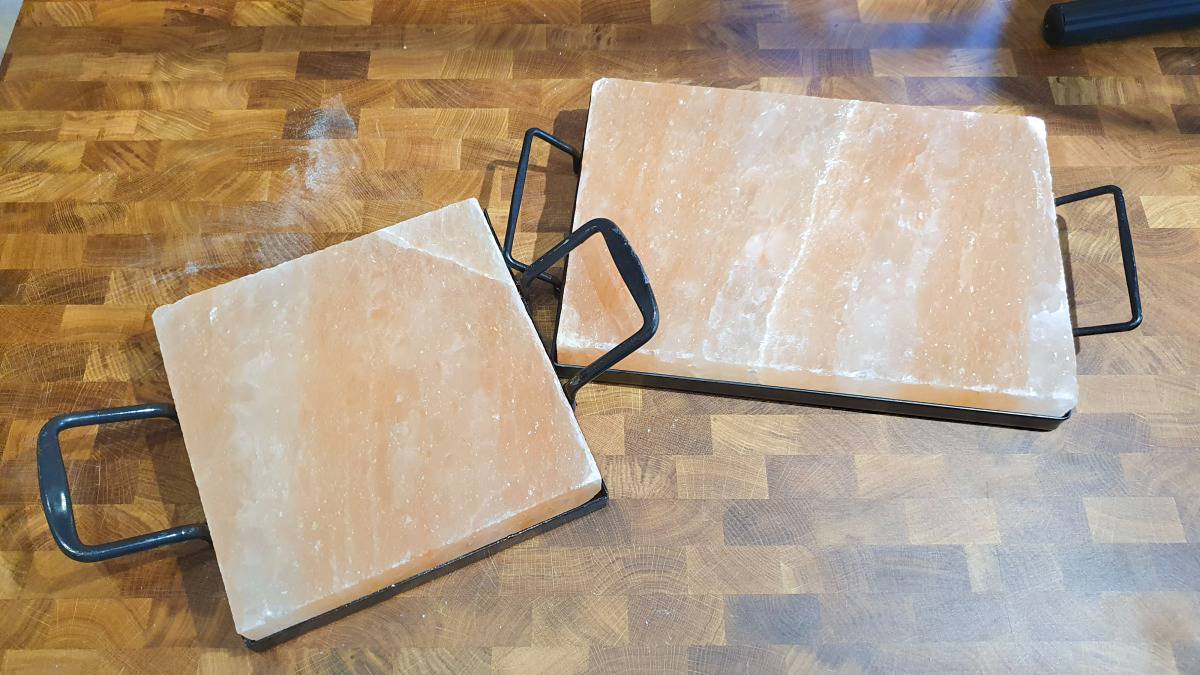
The beauty of this natural chunk of our planet is that it comes in any shape and size you want!
Used for bowls, lamps and even shot glasses too (so cool!), it can be chosen to work with the size of your grill and your choice of grilling items.
I have two favorites myself…a sizeable 8” × 12” × 2” which can grill several items at once and guarantees a big gasp of awe when brought to the table. And the smaller handy brick size of 4” × 8” × 2” which is great for when it’s just the two of us, a couple of steaks, a handful of shrimp or scallops. Perfect!
What Can You Cook on a Salt Block?
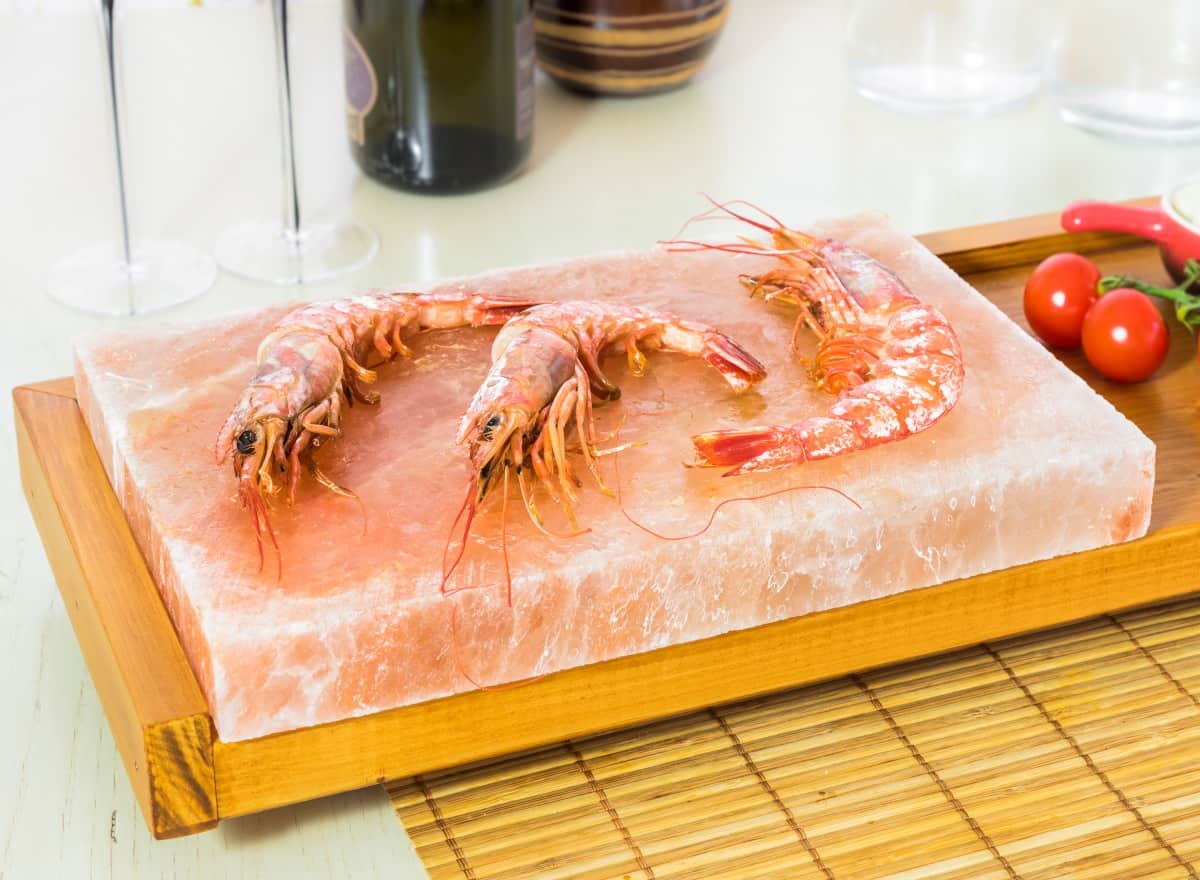
What can’t you cook on one?!
Steaks, scallops, fish, shrimp, pork, chicken, vegetables, and fruit. All delicious, delicately, naturally and uniquely seasoned, and you will go weak at the knees when you experience the crunchy seared golden bite that salt block grilling lends to meat.
That said, I must add that smaller cuts that cook quickly are best. This is fast, high-heat cooking on a screaming hot surface, so put the 15lb brisket aside for now.
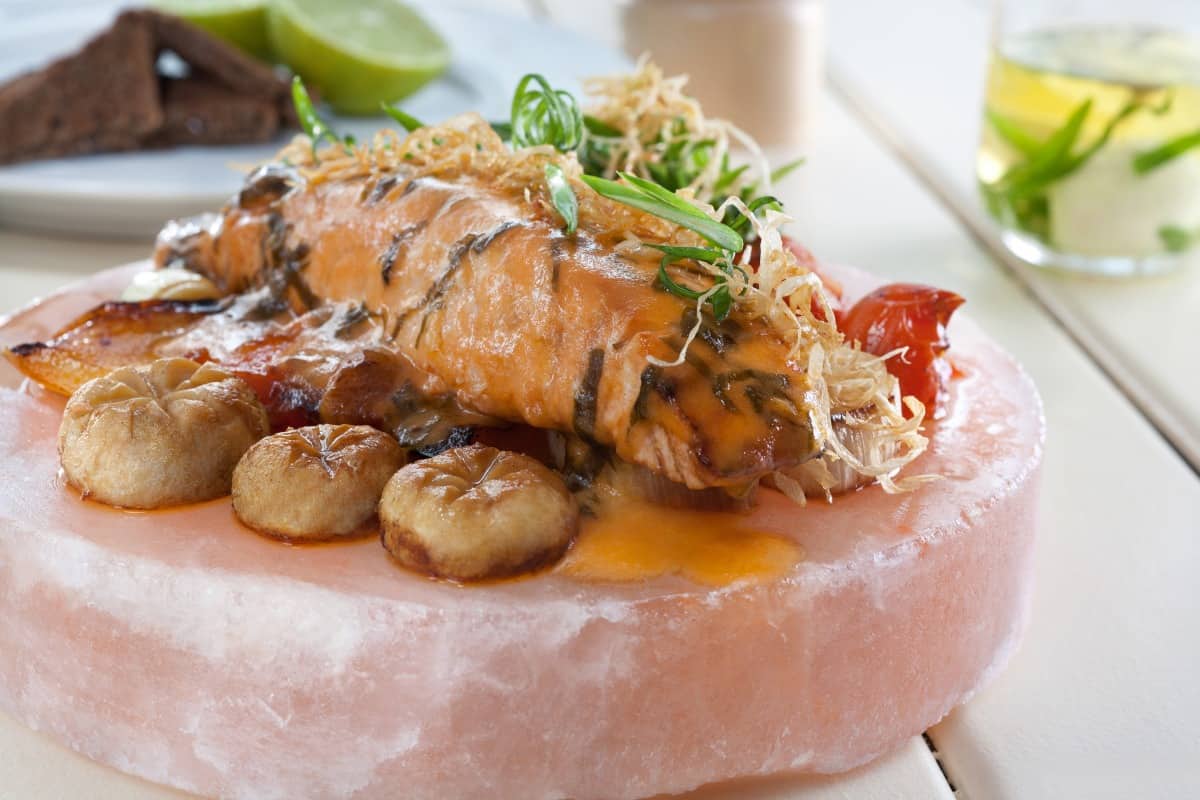
And always be sure foods hitting the salt block are dry as a bone. Wetness and marinades will only dissolve salt, causing too much to penetrate the food as well as premature erosion of the block.
How Does Salt Block Grilling Flavor Food?
When I first tried grilling using a salt block, I was kind of suspicious and braced myself for, well, a lot of saltiness. But here’s the thing, the surface of the block has extremely low porosity and is super-dense (as anything would be that’s been crushed by mountains and seas for a few millennia).
This means that the surface area of any food you put on it is minimally in contact with the block itself which in turn limits the amount of salt that actually penetrates the food.
Another factor that limits saltiness is high heat. Salt blocks should always be super-hot (around 500°) when you add food, so the surface of the food is then instantly seared preventing over-absorption of salt.
Instead, meats and other foods receive a beautiful light seasoning superior to regular table salt because of the presence of many trace elements and minerals.
To define the flavor is difficult beyond “added complexity” because every block will be different and who knows exactly what interesting minerals are locked inside the beautiful pink crystals. You’re just going to have to trust me on this one…and try it yourself!
For the soup-to-nuts on their use plus dozens of mouth-watering recipes, check out chef Mark Bitterman’s excellent book Salt Block Cooking.
Are Salt Blocks Hygienic?
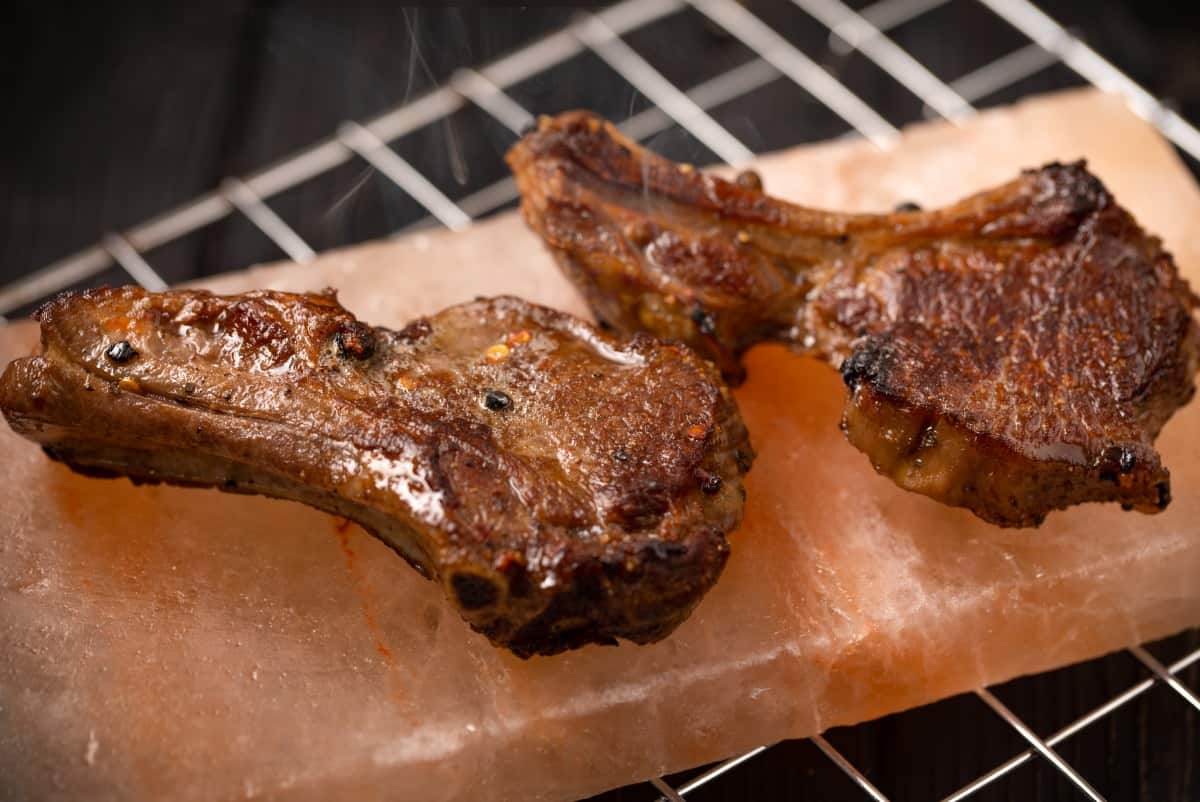
If ever there was a one-two punch in the sanitation line, it is the combination of high heat and extreme salinity.
Ain’t nothin’ going to grow in those conditions…bacteria, pathogens, microbes, nada. Bitterman says that salt blocks are “the most sanitary thing you can cook on.”
Salt Block Stardom: How to Impress the Guests!
We all like to think our grilling skills are enough to impress our guests, but a salt block takes it up a notch! With its gorgeous pink and red hues, it will always wow when food is brought in sizzling and seared. And because salt is excellent at retaining extreme temperatures, the food will stay hot for a good while at the table, no warming drawer required.
Better still, let the guests do the work! Heat up a salt block to 500° or so, bring it to the table in a special carrier for safety and to protect your furniture, and let people cook thin steak strips, scallops, shrimp and more right at the table. A kind of fondue experience without the cheese!
Salt Blocks Chill Too!
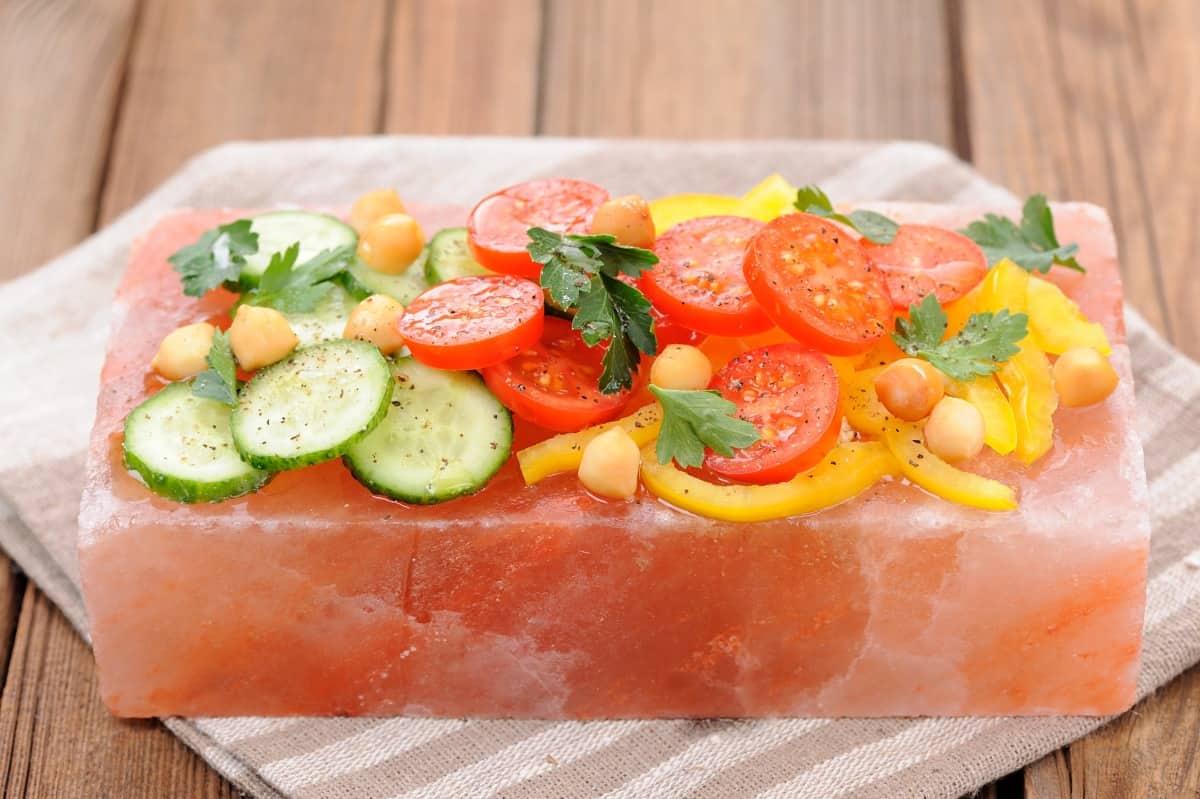
Boy, what can’t these superheroes do?! When a hot day challenges your ability to keep cold foods cold (think sushi or shrimp…things you absolutely do NOT want to eat room temperature on a hot day…), the salt block is your friend.
Toss it in the freezer for a few hours, and it will stay cold and keep food good and chilled for hours. And to think I used to put shrimp on ice on hot days. A soggy unappetizing mess after about 15 minutes!
And don’t worry about salting fruits or cheeses. The level of salt imparted is tiny, just enough to give a little flavor lift.
How Do You Clean and Store Salt Blocks?
OK, this is important, because you can wreck a beautiful new salt block by cleaning it the wrong way.
For starters, don’t hurry. It took a while to heat up, and it will take a while to cool down. Just leave it be until it’s totally cool before cleaning.
Rule #1: No soap or detergent of any kind. Bitterman goes as far as to say don’t use warm water because this will cause erosion as soluble particles break down and dissolve.
And never ever put a salt block in the dishwasher. It would probably be great for cleaning the dishwasher, but one good hot cycle will make the whole thing vanish (AKA dissolve)…poof!
Your best bet is to take a sponge or cloth, damp it with warm water and simply wipe the salt block down. If food particles are stuck on the block, you can use a green scrubbie or soft brush with a tiny bit of warm water before wiping with a clean sponge.
Always dry your salt block immediately and store in a dry place. In humid environments, I’d recommend wrapping the block in a clean cotton cloth to absorb air moisture. Experts say they should be allowed to thoroughly dry out for 24 hours between uses because any moisture that finds its way into the block will expand and cause cracks when heated.
And remember, high heat and the salt itself will ensure that no harmful bacteria can find their way to the inside. So maintenance actually, could not be easier!
A well-maintained salt block will last you dozens of uses, and bring you many moments of pleasure and presentational glory at the table!
How Long Do Salt Blocks Last?
Sadly, not forever. But with proper care and maintenance and especially smart heating as described here, you can expect a quality one to last a few years.
How often you use the block affects its lifespan too, of course.
Salt blocks will naturally wear down little by little with use, becoming thinner and possibly developing more fissures as they age. So the more you use it, the shorter its life will be. But hey, it will still be a life of good and delicious service!
And when your trusty block reaches an advanced age and becomes too cracked or too small to grill on…break it up and grind it into coarse pink salt. Delicious, food-safe and no waste!
Is Grilling with Salt Blocks Healthy?
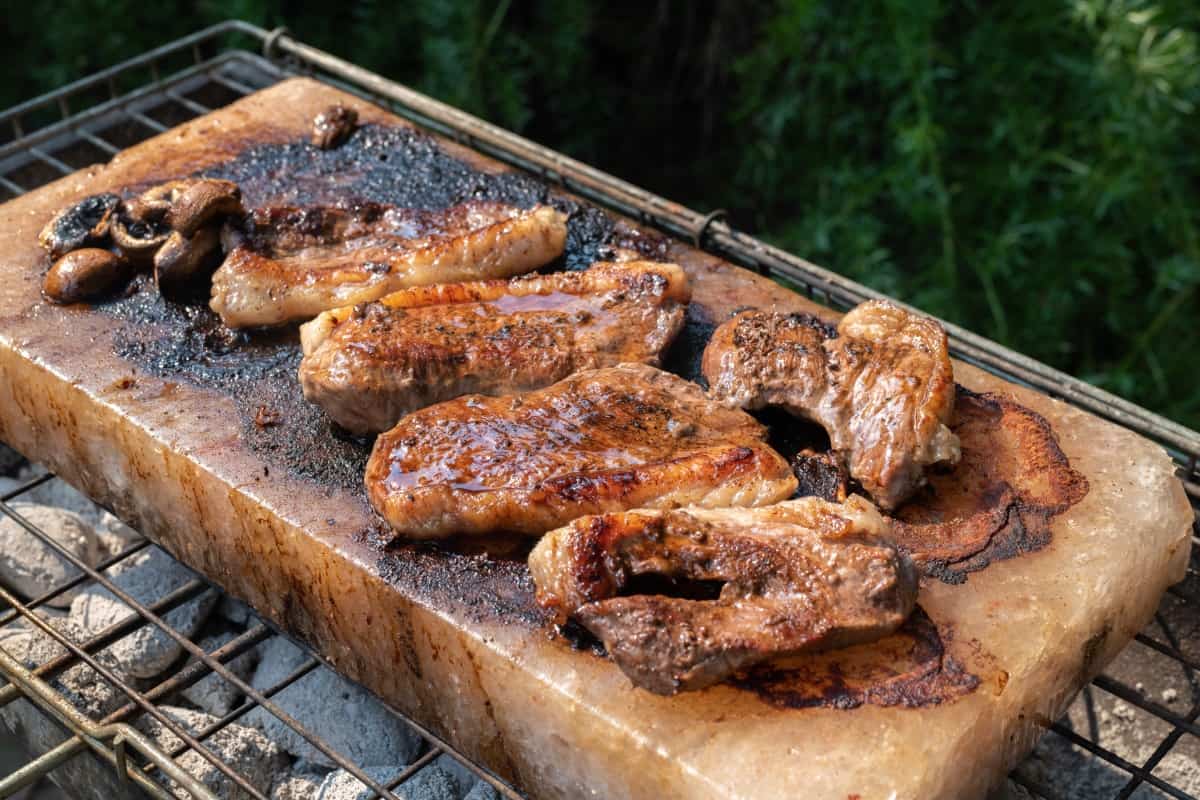
There are many opinions on this, but here are the facts.
Himalayan salt is:
- Unrefined and 100% natural
- Without additives (table salt usually has anti-caking agents added … Sodium aluminosilicate or magnesium carbonate).
- Typically around 2% minerals beneficial to our health such as calcium, potassium, magnesium, and iron
- NOT lower in sodium than table salt, but it tastes saltier and often comes in larger crystals so measure for measure, you can actually use less…which is healthy!
For an objective look at both sides of the health benefits question, check out TIME magazine’s thoughtful article, Does Pink Himalayan Salt Have Any Health Benefits?
How to Prepare a Salt Block for Grilling
Temperature changes deep in the Earth aren’t known to happen quickly, more like over thousands of years, so it makes sense that it would be a bad shock for your salt block to hit the grill at 500° for the first time.
The key to heating them is slowly, in stages. This is super-important the first few times you heat one. Kind of like a cast iron pan, it needs to be tempered and prepared gently for a lifetime of service.
Check out this short video for a how-to:
Put the salt block on the cold grill and turn the heat on low.
- With charcoal grills, this means setting up a 2-zone cooking area and setting the block first over the unheated side.
- With a gas grill, light half the burners and place the block over the unlit side.
Let the block heat slowly from cold to around 200 °F, approximately 15 minutes.
Then increase the heat to medium and let the block heat for another 15 minutes. You may notice some water accumulating at the edges. This is normal and will evaporate providing the block is warming slowly. If heated too fast, this internal moisture will expand and cause cracks in the block.
Finally, crank the heat high and let the block reach 500°. Don’t worry, the salt can take it — its melting point is almost 1500°.
It’s actually essential to allow the block to reach high heat before adding food. Any cooler, the food will not sear, and instead will take on too much saltiness, a classic rookie error with salt block cooking.
Will the Salt Block Change when Heated?
Yup! And this is important to recognize because I wouldn’t want you freaking out like I did when I saw cracks and fissures appear and my block turned milky white. This is all normal.
Salt, like rocks, has imperfections, natural fissures and discoloration and these things will react differently to heat and proteins in food.
Often, salt blocks become paler and opaque when heated, and they can develop cracks. The pinkness will often return upon cooling and cleaning. Or maybe it won’t. No two blocks are the same, and nothing with salt is entirely predictable. That’s the beauty of it. Repeated grilling will bring out the character and uniqueness of each block.
So yes, small cracks and lines are to be expected, no worries. Big cracks are not so good and are usually the result of heating too fast, so take care to heat according to the guidelines in this post to maintain its good condition.
How to Grill Using a Salt Block
Salt block grilling is super-easy, but it’s essential to follow a few simple rules.
Make sure any foods you are going to grill are:
- Dry (absolutely no marinade or wetness)
- Unsalted (duh!)
- Sliced to a uniform thickness that will cook fast.
Heat the block slowly in stages as described above (low, medium and high heat) over 45 minutes.
How Can You Tell if the Salt Block is Hot Enough?
Try any or all these quick tests:
- Sprinkle a little water on the heated block, when the block is hot enough, the water should sizzle and vanish almost immediately.
- Another test is if you can’t hold your hand a few inches above the heated block for more than 5 seconds…it’s ready!
- Or if you absolutely need to know numbers, an infrared thermometer can tell you exactly when the block hits 500°.
Top Tips for Successful Salt Block Grilling
- Always heat it slowly
- The recommended temperature for grilling is 500°. Anything less will cause the block to erode faster and make food too salty.
- Only use metal spatulas and utensils. Melted plastic on your beautiful pink crystal would be a shame indeed!
- Always use high-heat-resistant gloves, or even leather welding gloves to handle a hot block. Regular oven gloves will not give your hands sufficient protection. Also, if you plan on bringing the block to the table, investing in an inexpensive but sturdy rack is a good idea to protect your hands and your furniture.
- Use oven mitts for removing a chilled salt block from the freezer too. Freezer burn is no more fun than a heat burn.
- Never submerge or soak a salt block to clean it. Minimal water is the objective here, a damp scrub, a wipe clean, and thorough drying. No soap and no dishwasher.
- No marinated, wet or brined foods. Too much moisture will dissolve the salt in the block on contact and make the food too salty.
- Experts recommend designating a “top” and “bottom” so that the same side is always used for cooking. This will minimize stress on any small fissures that are created.
Salt Block Grilling: When the Old Ancient Thing is the New Best Thing!
For flavor, crispy crunchy texture, natural goodness and overall wow factor, grilling on a salt block is hard to beat.
Best of all, follow the simple steps here for heating and grilling, and you will find the process is actually straightforward, with wonderful results and minimal cost.
OK, so salt block grilling may be a bit of a fad, the latest hot thing and all that, but considering it’s already been around 600 million years, and it can indeed take your grilling experience to a whole new level, I think it’s safe to say it’s here to stay!
Have you tried grilling on a Himalayan salt block? What about chilling? What did you like about it? We’d love to hear about your experience! Please share with us in the comments below.
Thanks for stopping by.


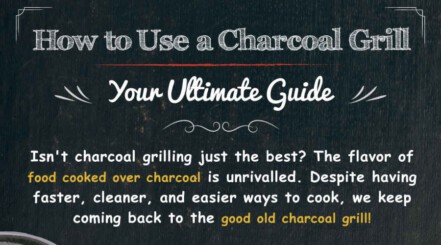
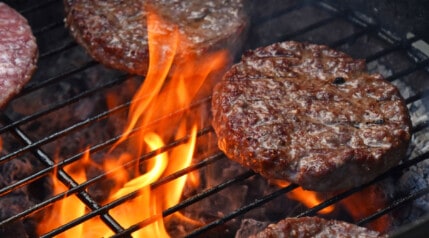
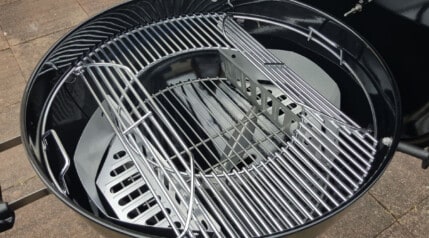

I’ve been looking for a while for scientific studies linking Himalayan salt composition to absorption of those minerals — or “dietary enrichment”, if you prefer — in humans. It’s actually how I got to this page, actually, although a year late almost to the date. 😉
Please don’t consider this is an attempt to debunk or criticize your work, or anything for that matter (the internet these days… One never knows!). I really don’t have any ulterior motives, I’m just honestly curious and interested in gathering knowledge about it, and would appreciate any response. Thanks, in advance.
Hi Lily,
I’ve not got any further info above and beyond what’s written above I’m afraid.
Hello I was wondering where do you find the 4”x 8”x 2” one? Thanks
Hi Kevin,
I actually got mine from a small independent, physical shop that sells salt lams, salt blocks etc. They don’t have an online presence. I’ve found one here on Amazon though.
Just curious — if you cook fish and then cook pork, do you have fishy pork? I’m wondering how the flavors transfer or if they do?
Thanks
Hi Robert,
if you cook them one right after the other, then I’m sure if there would be. But in separate cooks (fish one day, pork the next) then in my experience, no. I keep mine ‘clean’ by scraping off any residue, and ‘washing’ lightly with a very minimal amount of water — never any soap — after use. I’ve never noticed any taste transferal.
But truth be told, I rarely cook this way anymore. I liked theater of it, the whole ‘something different and interesting’, but honestly the results aren’t much different to cooking on a soapstone, or cast iron, then adding salt. Or what I’m think I’m saying is: The novelty wore off! Lol.
However, I will dig them out again this summer, because theater of it impresses people, and we eat with all the senses as it were.
Very informative, bought one, had no idea how-to use it. Thanks
Good information. Someone gave us four, 8 × 4 × 2 blocks, and we had no idea what to do with them. I heard something online about someone cooking with them, then found your site. I’m going to try it see how they are. Thanks for the info!!
Let us know how you get on!
For Christmas gifts this year … An avid griller and smoker person who grills with pellets, and someone else who has a gas grill. Can you recommend, or steer me clear of certain ones, to buy with the rack? Thank you.
Hi Renee. Sadly I’ve not looked into salt blocks for a long while now, my two are still going strong…but mostly because I do not use them too often (I tend to use my cast iron surfaces more, personally.) So I’m not aware of who offers the best ones right now.
Retired now…..but bought my first block! So excited to try with Venison filet!!
Thanks for sharing such an amazing article.
Used salt block for first time today. Did salmon on the grill 👏🏼. Can this block still be used inside, chilled, to serve cheese or shrimp?
Thank you.
Yes, that’ll be fine.